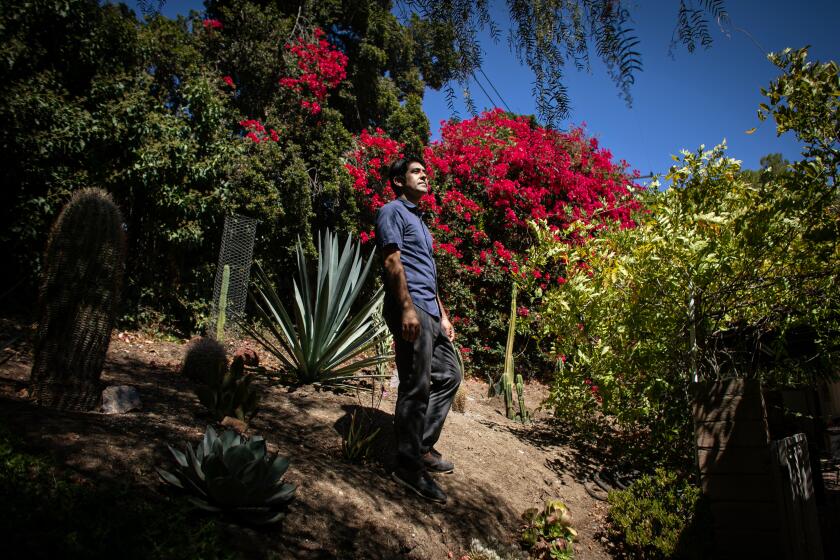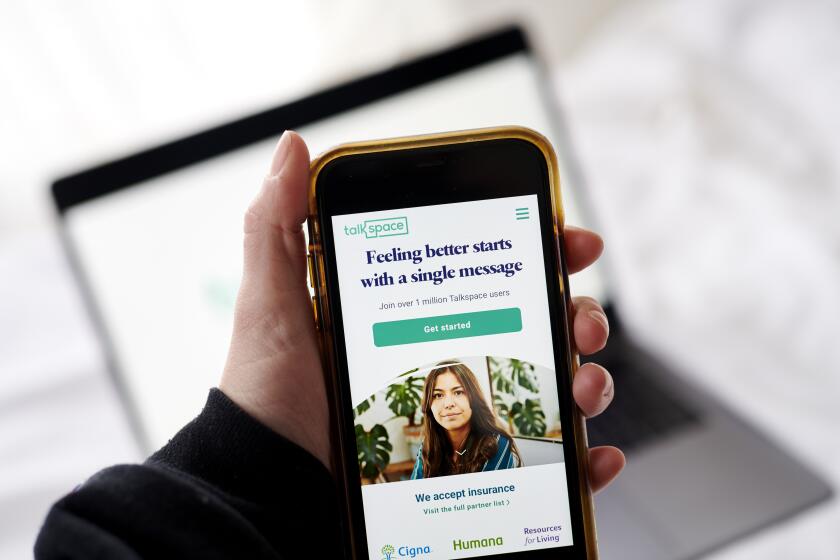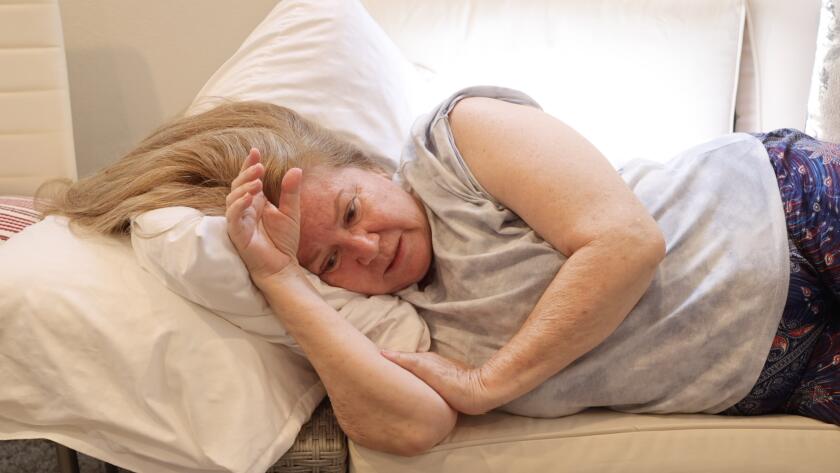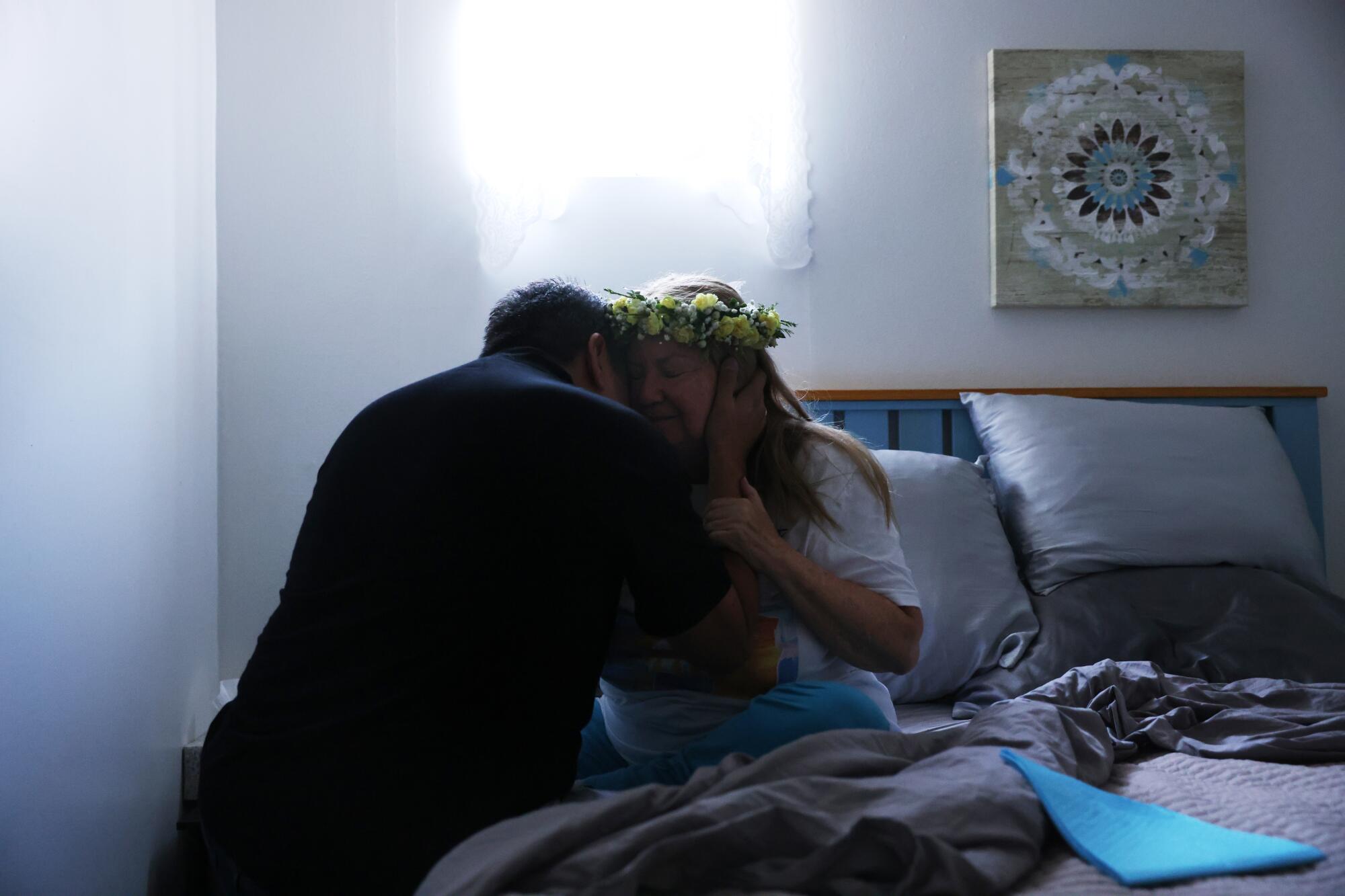
- Share via
Gabriella Walsh knew she wanted to die on a Saturday.
She’d settled on July 16, dressing that morning in a flower crown and a T-shirt with a picture of a dragonfly, an image that had comforted her in recent weeks. She took a deep inhale from a bottle of lavender oil and listened to a playlist of sea sounds.
Earlier in the morning, friends and family nuzzled up against her in bed. Rest easy, they told her, and keep wandering.
“I just feel like I’m going on a trip,” she said calmly.
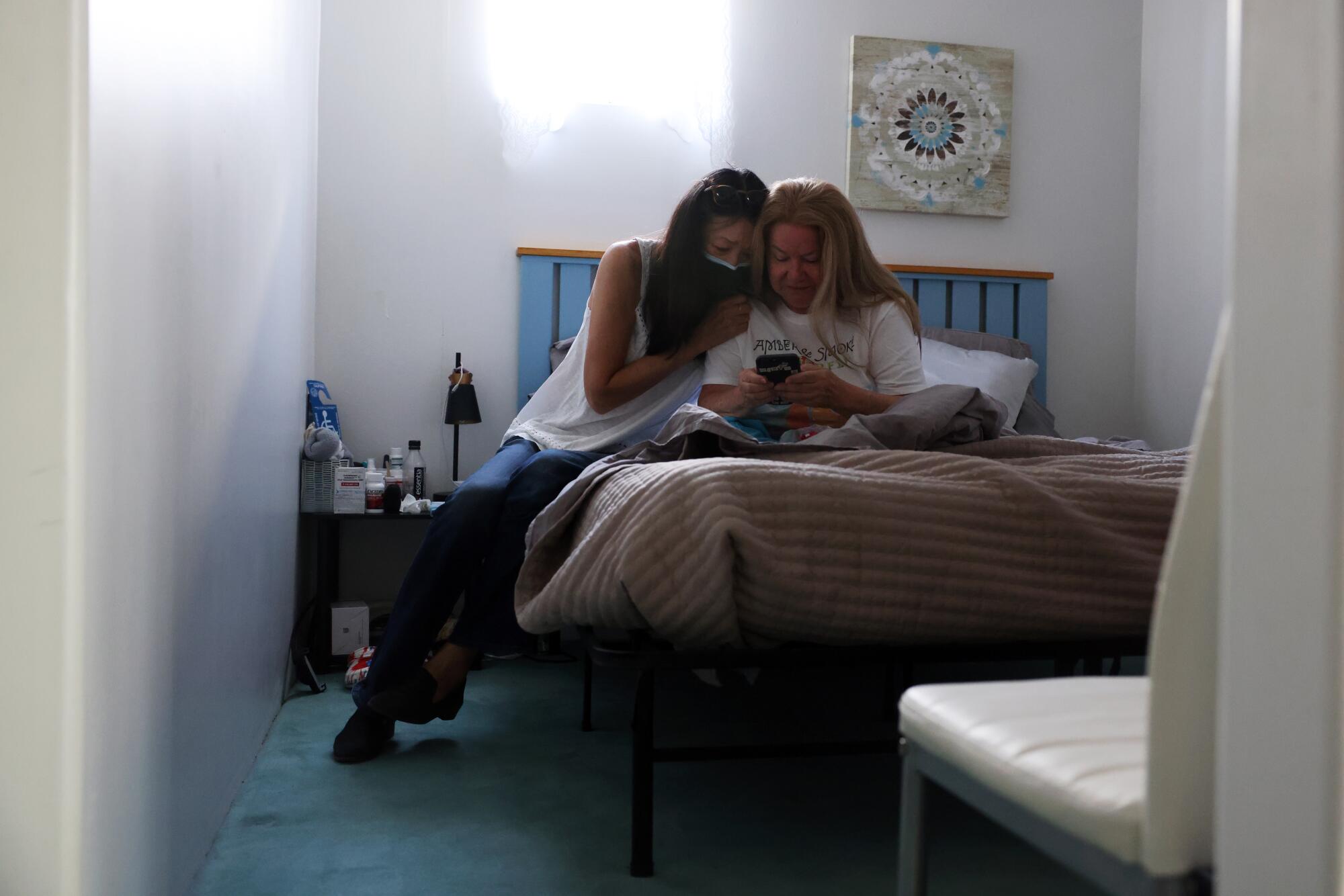
Within two hours, she would drink a fatal dose of medications prescribed under California’s death-with-dignity law, which allows some terminally ill patients to request drugs to end their lives.
The option had given her profound comfort in her final weeks — as had knowing that, in the end, she’d have Jack Barsegyan, the registered nurse who managed her hospice care, and Jill Schock, a death doula, at either side of her bed.
“My Jack and Jill,” she often called them.
Born Gabriela del Carmen Torres Acosta on the first Friday of 1958, death was, perhaps, her earliest memory, thus stripping away much of her fear of it.
When she was 2, she stumbled upon her grandfather slumped lifeless in the hallway of their family home in Quillota, Chile, an agricultural community north of the capital. A few months later, a chance illness — gorging on so many strawberries that she got severe diarrhea — led to an appointment where a doctor discovered that a small opening in her heart had never closed properly after her birth. She soon underwent open-heart surgery.
Another five years passed, and during their bedtime ritual, her father asked her to let their hug linger, sensing it might be their last.
“Este puede ser nuestro último abrazo.”
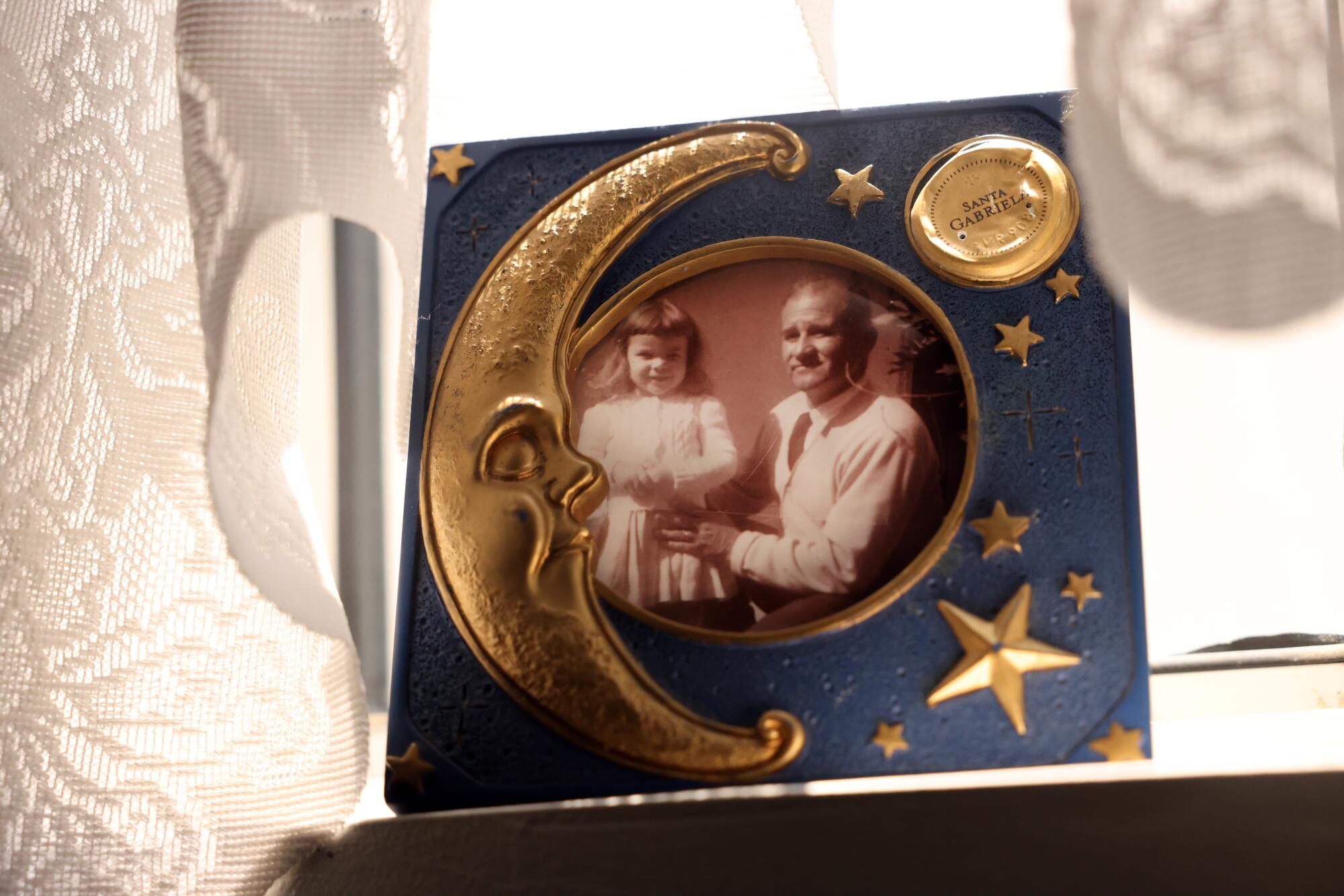
He died of a stroke within hours, and his body was transported home from the hospital, as was often the custom then. Once the adults cleared out of the living room, she dragged a chair next to her father’s body, which was covered by a sheet, and rested her small hand on his shoulder. She sat with him for what felt like an hour.
“I had no fear,” she recalled. “I was neutral.”
In junior high, she and her mother moved from Chile to Sherman Oaks, where they reunited with Gabriella’s oldest sister. She now had a new home, a new language and a slightly new name — “Gabriella” with two Ls after officials misspelled it on immigration paperwork.
After graduating from Van Nuys High School — where she met a group of girlfriends she stayed close with through the years — she got a job as a medical assistant helping a podiatrist who worked at convalescent homes. The patients often looked unkempt and rarely had visitors.
“That’s not how I want to have my last days,” she thought, then 19.
Before long, a co-worker introduced Gabriella to her brother, who became Gabriella’s husband. They wed at a chapel on Topanga Canyon Boulevard. A little over a year later, when she was 23, she gave birth to a little girl she named after actress Natalie Wood. She felt immediately in awe of her daughter, but also deeply unprepared to be a mother.
Through the years, she worked in advertising and as a personal assistant and, later in life, as an interpreter and translator. She was, for a time, a born-again Christian, a faith she followed her ex-husband into and left around the time they separated. Later came a yogi phase, another she described as a Buddhist vibe, and then, in the end, nothing at all.
She was long guided by a spirit of wanderlust — a word she had tattooed onto her left wrist in her late 50s. She’d always despised monotony, put off by the idea of being too tied down to a single place. She rarely considered the future or the longer-term impacts of quick decisions — her allegiance was to the now and the immediate next. No matter where she was, or whom she was with, she always itched for new adventure and opportunity.
“If there was a chance of something — some connection, some job, some friendship — it was, ‘I’m in. I’m all in,’” recalled her longtime friend Kathy Menzie.
Gabriella lived, for a time, in Miami and Australia, and traveled through Mexico, Guatemala, Costa Rica and the Caribbean, where she sailed on a boat called the Knauty Knott. In the mid-2000s, she visited Amsterdam with an employer-turned-friend who was researching cannabis and steroids in bodybuilders. Maybe she’d return when she was older, she thought, knowing that the Netherlands had a death-with-dignity law on the books.
In her final weeks, while paring down belongings, she found a folded piece of graph paper with names and short descriptions of long-ago lovers.
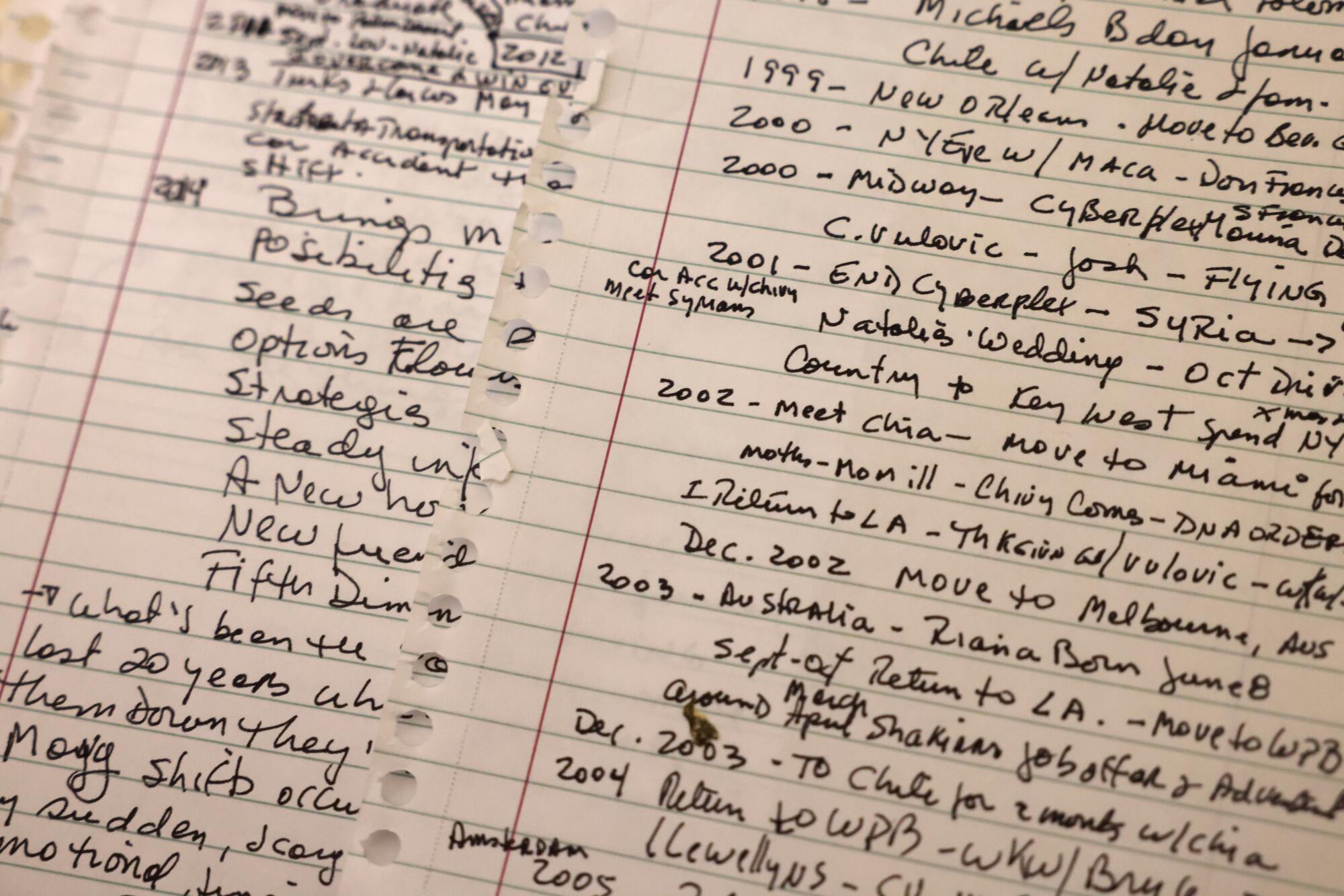
Redhead.
Guy with the Green Suit.
Band Leader.
Of all her experiences, her purest joy came in 2003, when her daughter picked her up at Los Angeles International Airport after Gabriella had spent several months working in Melbourne. The moment she first locked eyes with her granddaughter, then 3 months old, felt transcendent.
“Just magical.”
By the fall of 2021, Gabriella had retired — arthritic pain in her wrists made typing for translation gigs painful — and she yearned to travel.
She did her best to stash away savings from her $1,100-a-month Social Security payments and started sketching an itinerary: three months in Spain, one in Ireland, a few weeks in Chile or Australia. She rented a flat in the Spanish city of Alicante, a friend’s hometown, and purchased a plane ticket for Dec. 27.
On Dec. 9, she went in for a routine mammogram and, minutes later, a radiology oncologist was explaining, in a calm tone, that aggressive cancer in her right breast had “blown out” to her lymph nodes.

Blown out. Blown out. Blown out.
The words looped in her mind. She sobbed alone in her car and drove straight to her general practitioner’s office, asking them to set her up with an oncologist.
Insurance calls blurred together and she canceled her trip. With her plan to move out of her current residence in motion, she needed to find a new place, which filled her with anxiety. But soon an old friend offered to let her stay with him at his home in Valencia for a few months.
A PET scan showed tumors on her spine, sternum and hip. Fifteen in total — now officially bone cancer, her oncologist explained at an appointment in March. Prognosis, she knew, was an imperfect science, but she recalled the oncologist saying he thought she had six to eight months to live. She could do hormone therapy, which might slow the progression.
“My life, my body, my death. It’s just my time.”
— Gabriella Walsh
She didn’t want to extend her life, she told him, but to prioritize the quality of the time she had left. In her final months, she shared freely with family and friends about her decision to pursue California’s End of Life Option Act, a law that took effect six years ago, after then-Gov. Jerry Brown, a former Jesuit seminary student who wrestled with the decision, ultimately revealed his support in a public letter.
“In the end,” he wrote, “I was left to reflect on what I would want in the face of my own death.”
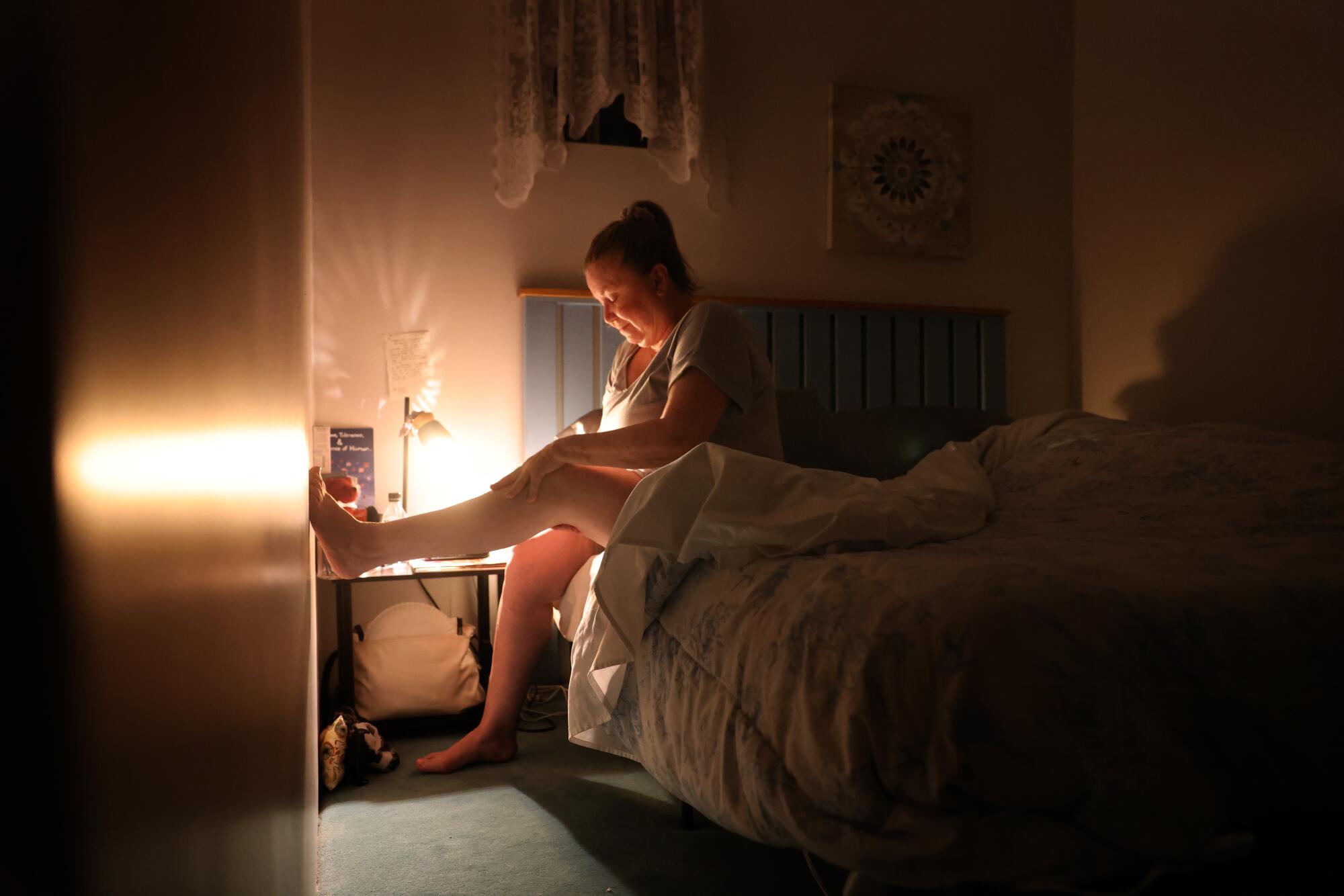
The law, which was updated in January to streamline some red tape for patients like Gabriella, makes California one of only 10 states, as well as the District of Columbia, to permit medical aid in dying. Despite the leeway written into the California law — physicians can decline to prescribe the fatal cocktail of medications and patients who receive the drugs don’t ultimately have to take them — Gabriella quickly learned that the measure still has many vocal detractors.
Medi-Cal patients diagnosed with complex cancers often find themselves shut out of the best care -- even when that exclusion is a life-or-death matter.
In mid-May, Schock informed her that a group representing Christian doctors had filed a federal lawsuit against California Atty. Gen. Rob Bonta and other state officials, hoping to invalidate parts of the updated law. Schock and Barsegyan, the nurse at Physicians Preferred Hospice who managed Gabriella’s care, rushed to secure her medications before the next court hearing, which was ultimately postponed. At one point, Gabriella said, her general practitioner even called to plead with her.
“You have to fight. You’re a fighter.”
Conversations like that were uncomfortable, but Gabriella was resolute. The decision gave her a profound peace — a final freedom that she hoped would one day be afforded to people in every state.
“My life, my body, my death,” she said. “It’s just my time.”
The first days after her diagnosis felt like fog.
Her mind floated back to the strawberries that may well have saved her life as a toddler and the time, years later, when she was hospitalized with severe heat exhaustion while training for a 5K. She daydreamed about getting a blue parrotlet — maybe she’d name him Freedom and have him released into the sky after she died — and she cherished visits with her daughter and two grandchildren.

She learned to steady herself with a cane, knowing that even a short fall could shatter her brittle bones, and she reflected on life lessons that had long eluded her — the way, unless she had a specific goal, she struggled to manage money and how hard she found it to assert her own needs if she thought it would let someone else down.
She caught up with relatives in Chile, reminisced with her ex-husband and began drafting notes to family members she still had unresolved feelings toward. She sometimes craved sopaipillas, a doughy treat commonly eaten on rainy days in Chile, and often thought about Brandon — whom she’d become the legal guardian of several years earlier after her former brother-in-law, who raised the then-teenager, had died — and how he could make her laugh in any circumstance, even this one.
“I’ve lived a magical life,” she said one afternoon in March. “What else can I ask of life?”
Friends flew in from Atlanta, Colorado, Spain and locals showed up with sushi and Krispy Kreme doughnuts and CBD oil for her aching knees. They laughed and cried and sometimes she gave them tarot readings.

On April Fools’ Day, she moved to the 47th — and final — address she’d call home. Menzie, her longtime friend whom she met as a teenager, had offered to let her live for free in a small studio adjacent to her stepfather’s home in Santa Paula. Menzie lived in a separate guest house next door.
When Gabriella first walked in, light shone through the window, casting an abstract, golden shape onto a baby blue comforter. Menzie had set out yellow tulips, Gabriella’s favorite, and dark chocolate with almonds.
People who have trouble getting in to see a therapist are turning to online providers that offer quick access. But there’s limited data on their effectiveness.
“What a blessing,” Gabriella whispered.
Menzie zipped in to clear a few final things from a bookshelf, and as she scooped up a Nativity set, two figurines tumbled to the carpet.
“Jesus and Mary!” she shouted.
“No, that’s Joseph,” Gabriella teased.
They both threw their heads back in laughter. Someday soon, Menzie said, I want to take you to the Cajun spot down the street for beignets. Or maybe we’ll get pedicures or go to trivia night?
“We gotta do it sooner rather than later, girl,” Gabriella said.
Soon, the tumor on her hip stung so much it was hot to the touch, and when she lay down to watch TV, a mass along her spine squished like an about-to-burst water balloon. She nibbled on sardines and water crackers or berries with maple syrup, and her painkillers constipated her so badly that the discomfort sometimes triggered anxiety attacks.
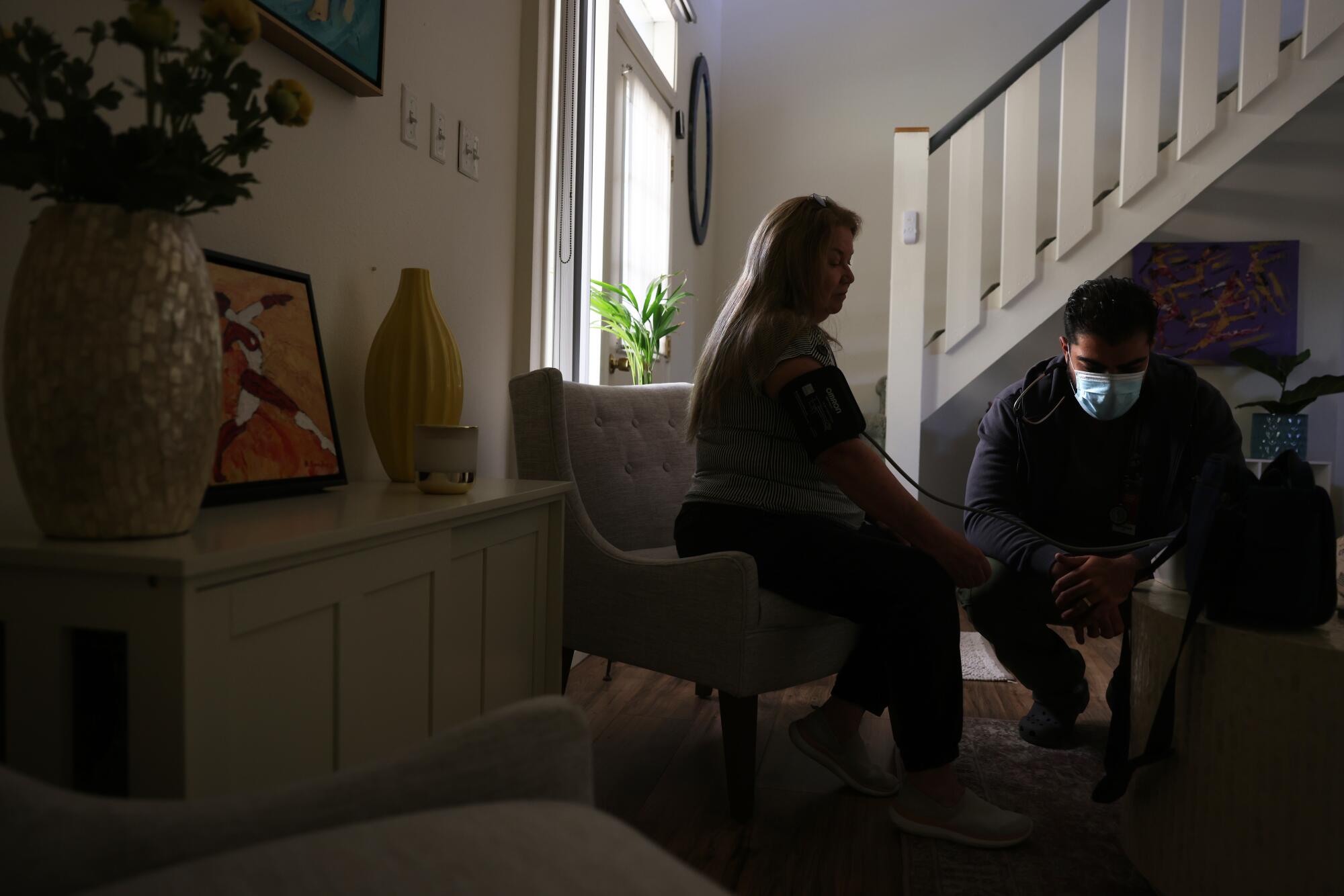
Her hospice team upped the dosage of her fentanyl patch, which helped. A few days later, Schock visited.
The 36-year-old death doula, whom Gabriella hired to walk alongside her in her final months, used to work as a chaplain in an emergency room, but disliked the realm of sudden death — a place, where on a Saturday shift she’s never forgotten, a young father who didn’t know he was allergic to bees died of anaphylactic shock after being stung at his son’s soccer game. Cancer was unrelenting — she’d watched it kill her own father in 2015 — but at least patients had the chance to say goodbye.
“What are you doing with this time to get joy out of life?” Schock asked Gabriella during a visit in April.
Walking along the beach sounded taxing, but she would enjoy sitting by the waves. And after a few days of wanting to be alone, she felt up for visitors.
“It’s OK to be more antisocial,” Schock told her. “That’s actually a part of the dying process.”
Gabriella was still experiencing nuggets of joy and they were all tied to connection — a five-hour meal at Nobu in Malibu, seeing Dave Chappelle at the Hollywood Bowl, the friend who knew she ran cold and mailed her an electric blanket.
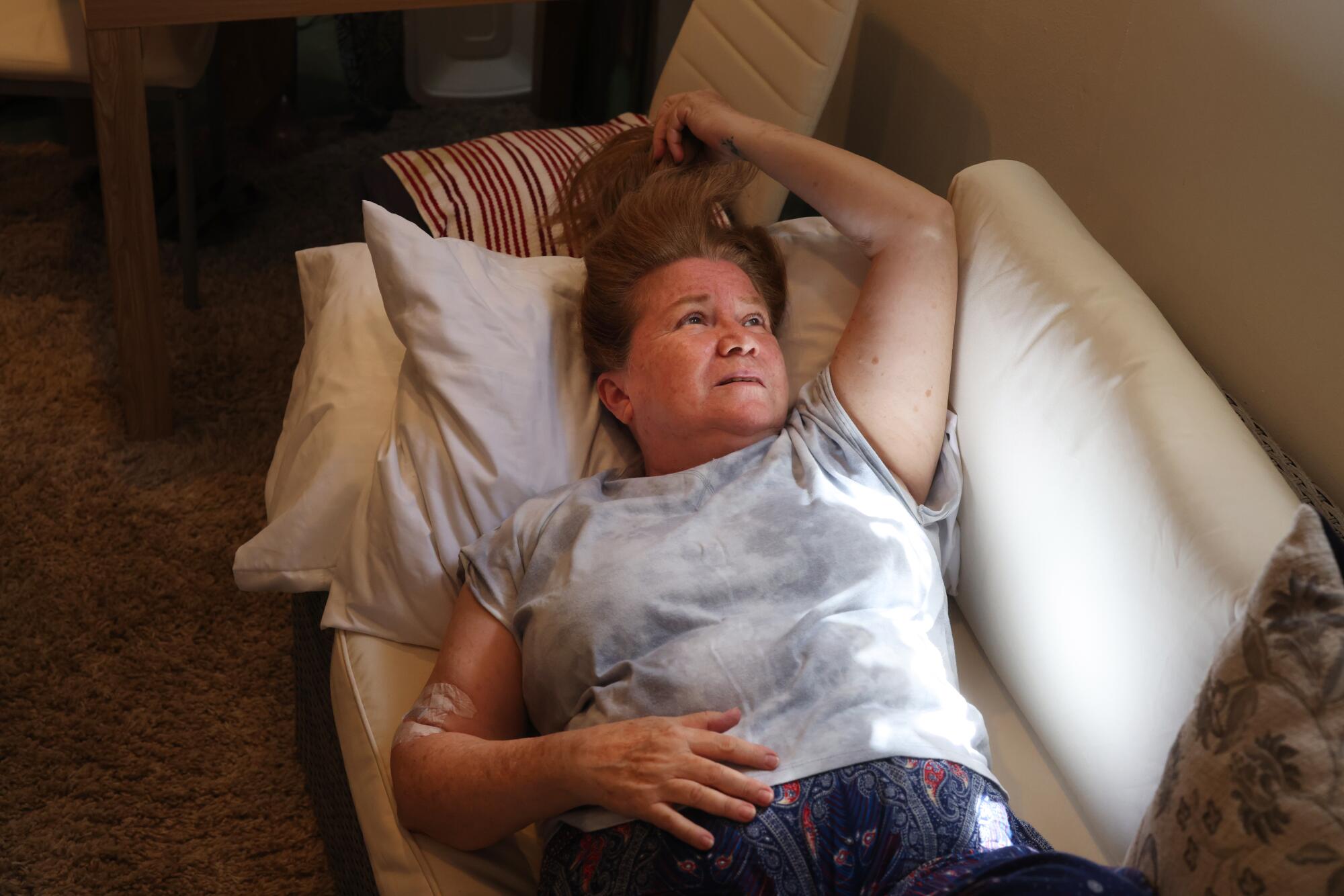
But she didn’t like where her mind went when she was alone. Detached and exhausted, listening to music became painful, transporting her to lighter times, so she zoned out to audiobooks and binged “The Lincoln Lawyer” on Netflix.
She often fixated on not wanting to burden the people in her life, fearful of asking for too much. And yet, she wanted more — more visits and calls and connections. Feeling disconnected from her dying body, she removed her fentanyl patch for a week.
“I needed to feel.”
Every inch of her small frame, including her hair, ached and scrubbing shampoo into her scalp exhausted her. She pulled up the calendar on her phone, checking to see what she had coming up in the weeks ahead — a loved one’s birthday — but after that she was clear. She called Schock.

“I’m having a really hard time just waiting around,” she told her. “Can I set a date?”
All the paperwork had gone through; she could set any day now.
“Any date?”
“Any.”
“July 16.”
Until then, she felt as if she was traveling on standby — now, she said, she knew what time she needed to board.
“Just like any other trip I’ve taken.”
A few mornings later, her hairdresser-turned-friend Rebecca Rincon visited with two bottles of prosecco.
“Hey, babe,” Gabriella greeted her.
Rincon wondered aloud if Gabriella believed in an afterlife. She’d gone back and forth through the years, Gabriella said, but now she didn’t think she did.
“I really feel that once I fall asleep, it’s lights out.”
Rincon thanked her for speaking so freely about death — an example she’d tried to follow recently when broaching the topic with her own parents.
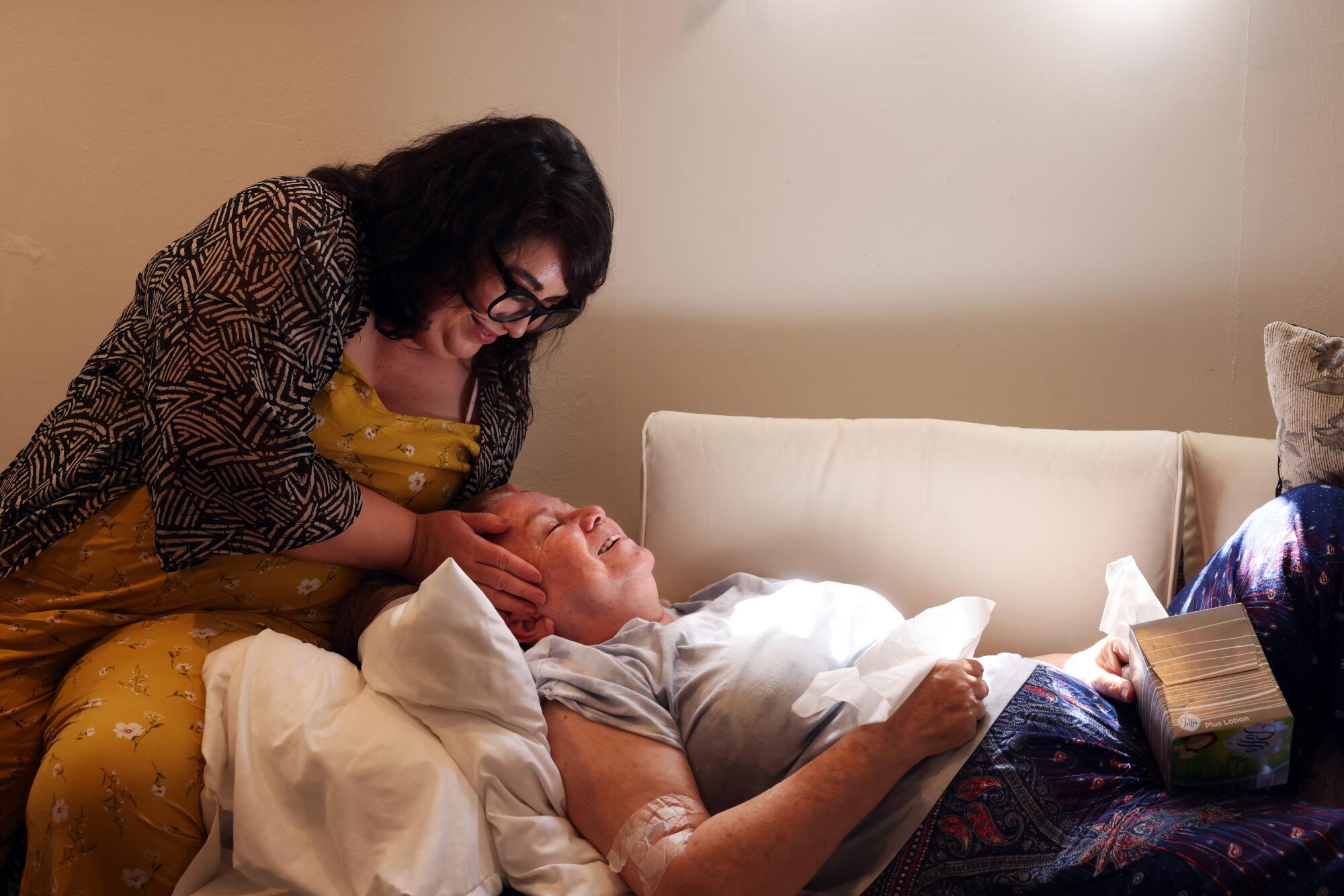
“You’re gonna be a teacher beyond this realm.”
“I hope so,” Gabriella said. “I have no idea what’s on the other side.”
Just don’t pull at my feet while I sleep, Rincon teased her.
Another friend had recently asked her not to tickle him at night, Gabriella said, and someone else told her they hoped she would show up to them as a dragonfly landing on their nose.
If I ever get a free drink from a stranger at a bar, Rincon told her, I’ll know it’s you. Gabriella’s eyes twinkled.
“Te quiero mucho,” Rincon told her. I love you.
“Y yo a ti.” I love you too.
Small moments like these always felt to Gabriella like a living funeral, an opportunity to listen in on the things loved ones might normally save for a eulogy.
“It’s been a gift to be able to die in this way.”
Many nights, she reread a text message she got from a high school friend, Collette Hillier, telling her that she’d long felt closer to her than most anyone in her life — even her husbands. She’d always admired her courage, but never more than now.
“There will never be another you,” the message said.
Gabriella wept every time she read it.
On days when she had the energy, she sorted her possessions into piles — her old matchbook collection for her granddaughter and a silver pendant from Easter Island for Hillier. She prepared a box for Brandon, filling it with his old high school essays and a bracelet a friend gave her from Indonesia.
“I’ll need to hear your voice. Your laugh.”
— Collette Hillier
On the first day of her final month, Gabriella stayed in bed past noon.
Her arms throbbed so much at night that she sometimes dreamed of cutting them off. Menzie knocked, walking in with buttered toast, scrambled eggs and strawberries.
“Thank you, babe.”
Gabriella picked at the plate, mentally preparing for a goodbye video call with her longtime therapist.
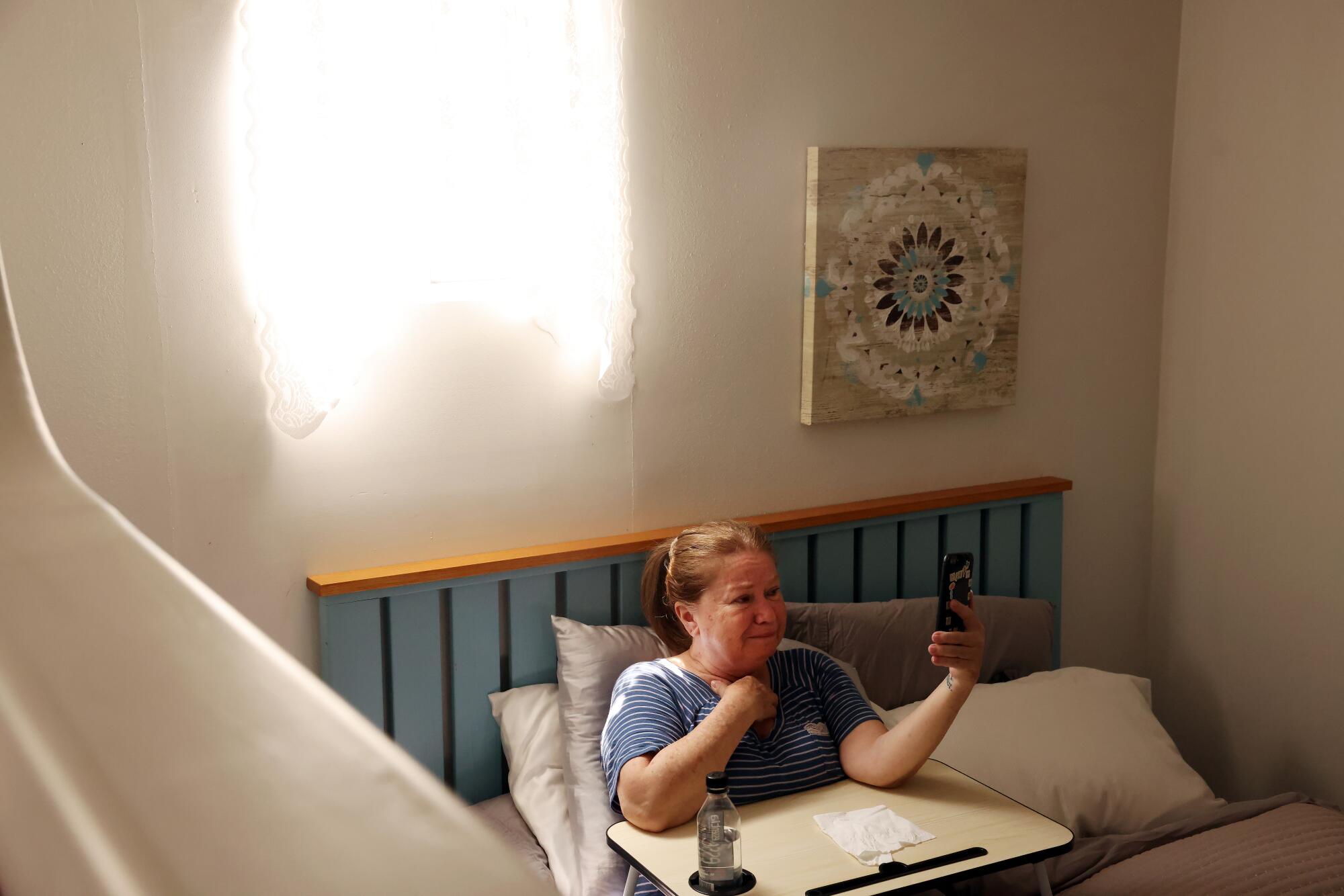
Time was moving so slowly, she told her therapist, and she was eager for July 16. She cried as she explained that friends were planning to fly in ahead of that day.
“I’m not surprised at all,” her therapist said tenderly.
“Know I love you and know I thank you so much,” Gabriella told her.
“I love you too,” her therapist said.
Gabriella blew her a kiss and hung up.
A few days later, Hillier visited from San Luis Obispo. They drove to Ventura and sat on a bench overlooking the Pacific.
Gabriella had been coming to this exact spot since the ’70s — once to decompress for a week in her 20s, countless times to push her mother in a wheelchair up and down the promenade and, again, a few weeks earlier for a final visit with Brandon.
Her friendship with Hillier had ebbed and flowed through the years, through busy patches, but whenever Hillier was in trouble, she always leaned on Gabriella.
“My guardian angel,” she whispered, pulling her tightly to her chest.
They sat silently for a moment, staring out at the ocean that they both respected so deeply. Their feet dangled and spun in small circles like they were young girls again. Beach girls, just as they’d always been.
A random thought popped into Hillier’s mind — the type of small, silly thing she loved to bounce off Gabriella — and when she shared it Gabriella laughed so hard her entire body shook. That laugh.
Hillier had started to keep all her voicemails.
“I’ll need to hear your voice. Your laugh.”
On her drive to Santa Paula on July 16, Hillier hit more traffic than she’d expected. She knew Gabriella planned to ingest the medication around noon and started to worry she might not make it in time to say goodbye. Then a dragonfly landed on her windshield, calming her nerves.
In Santa Paula, she turned down Main Street and passed a hair salon before walking to Gabriella’s studio, which was tucked behind a gate. Friends and family had gathered beneath a pergola. When Hillier walked into the studio, Gabriella handed her a small square photo they’d taken together at Santa Monica Pier when they were 19.
Between her final goodbyes, Gabriella held her phone, trying to figure out how to delete her email account and deactivate her Instagram. She’d meant to do it sooner, but never quite felt up to it. She spent some alone time with her daughter and snuggled in bed with her niece and granddaughter.
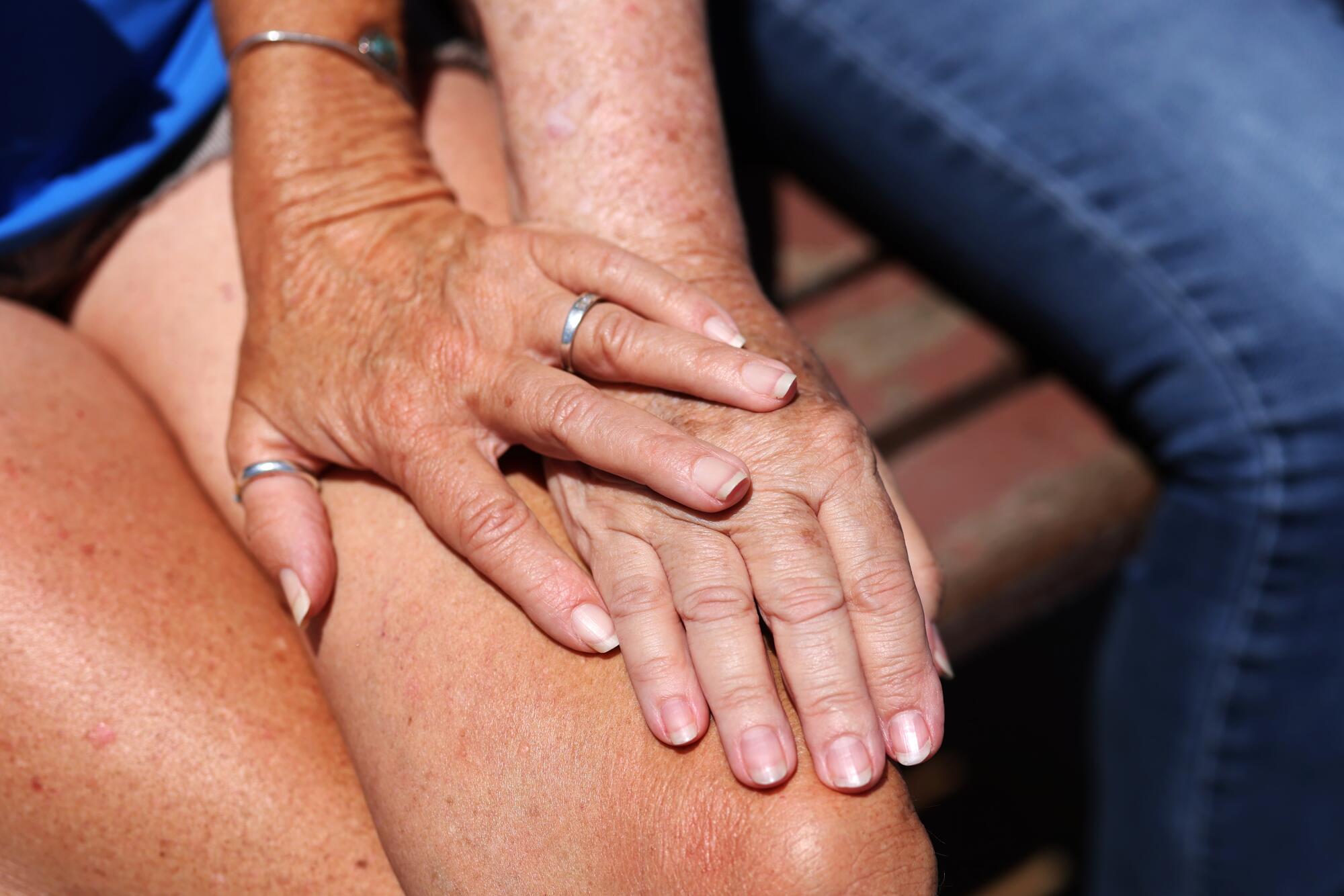
Barsegyan asked if she was feeling any anxiety. About a 5 out of 10, she said, so he gave her something to calm her nerves. When he walked up several minutes later holding a small, red vial, he reminded her — as he had many times before — that she didn’t have to drink the medication, but that if she did it would end her life.
She nodded.
Schock fed her three spoonfuls of mango sorbet, which Gabriella had picked out several weeks earlier, knowing it would soothe her throat from the stinging medication. Barsegyan handed her the vial, and without hesitation, she put it to her lips, swigging it down in three confident pulls. She looked up at the ceiling, smiling softly.
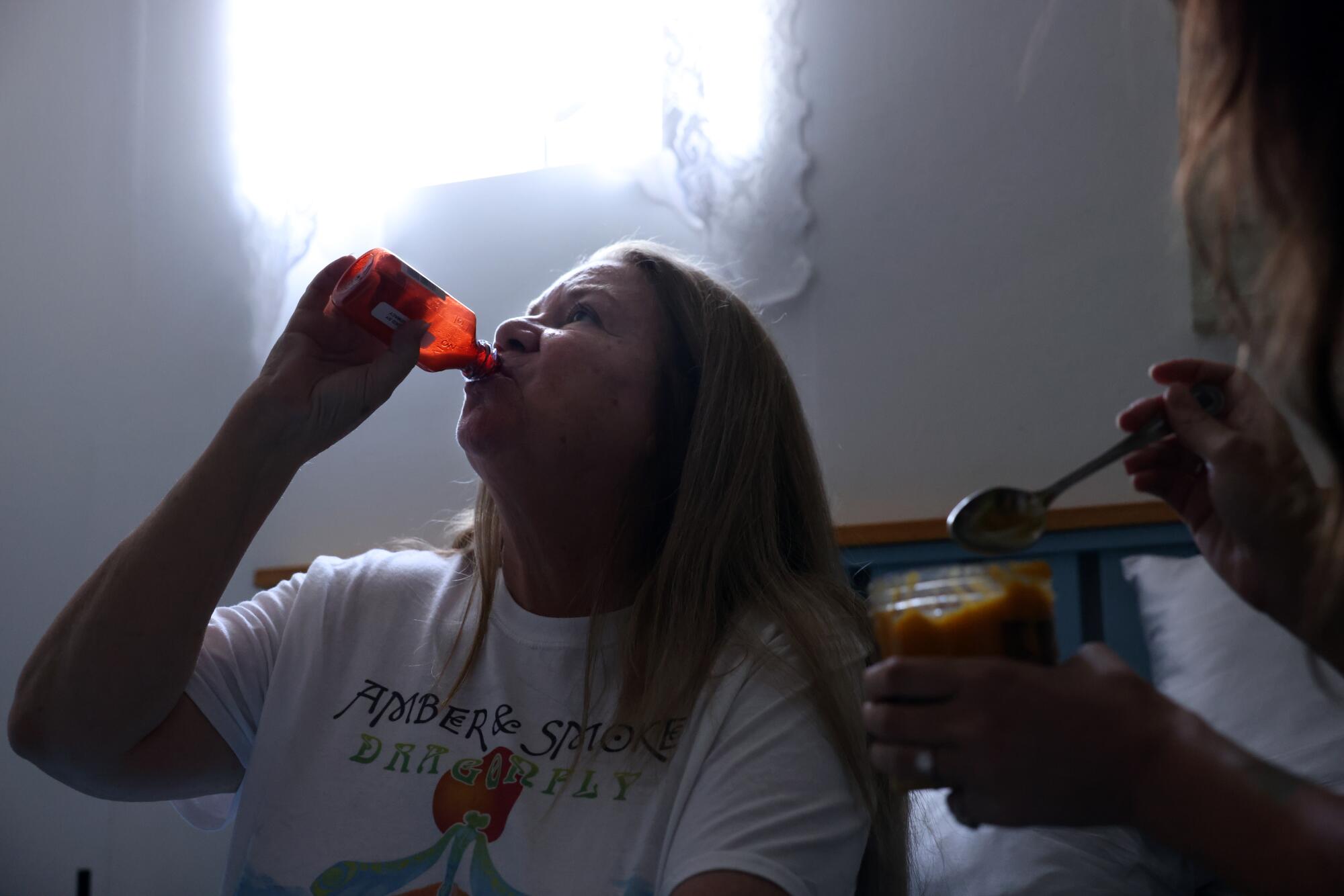
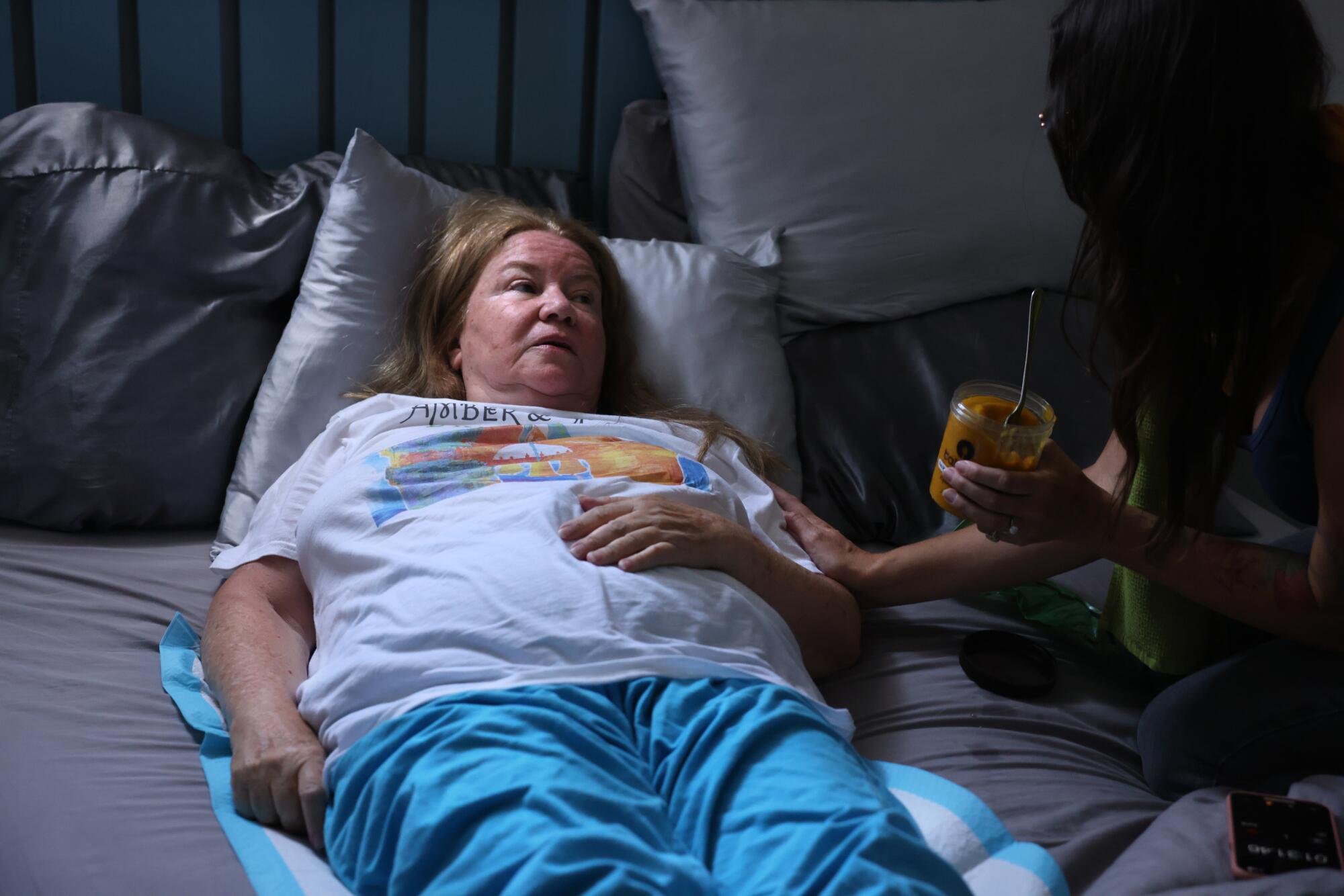
She died at 1:38 p.m. She was 64.
A day earlier, she’d been burrowed into a seat at the movie theater with Menzie and another dear friend since high school, Melanda Woo, on her left and a friend who’d flown in from Spain on her right.
She’d recently listened to “Where the Crawdads Sing” on audiobook, so when she heard the film adaptation would be released on July 15, she knew she wanted to see it.
As the lights dimmed, Gabriella tucked one hand in the other, twiddling her thumbs. She stared up at the previews, all with release dates well after she’d be gone. The lights dropped one final increment and a blue heron soared over a shoreline. As the camera panned through a lush marshland, a voiceover played.
A swamp knows all about death, and doesn’t necessarily define it as tragedy.
Gabriella watched intently as the story of a young woman’s loves and losses unfolded on the screen. The film ends with an aerial shot of the protagonist dead in a boat floating in the marsh that she loved so deeply. Then it cuts to a wide shot of small blinking lights and the voiceover returns.

I am the marsh now. I am a firefly. That’s where you’ll always find me, way back yonder, where the crawdads sing.
As the credits rolled, Gabriella put her pointer fingers into the corners of her eyes and wiped away two small tears. As the other movie watchers filtered out, her friends’ cries began to crescendo. When the music finally cut out, the sound of their heaves filled the theater.
Gabriella sat misty-eyed, but silent, tight in their embrace.
- Share via
Watch L.A. Times Today at 7 p.m. on Spectrum News 1 on Channel 1 or live stream on the Spectrum News App. Palos Verdes Peninsula and Orange County viewers can watch on Cox Systems on channel 99.
More to Read
Sign up for Essential California
The most important California stories and recommendations in your inbox every morning.
You may occasionally receive promotional content from the Los Angeles Times.
